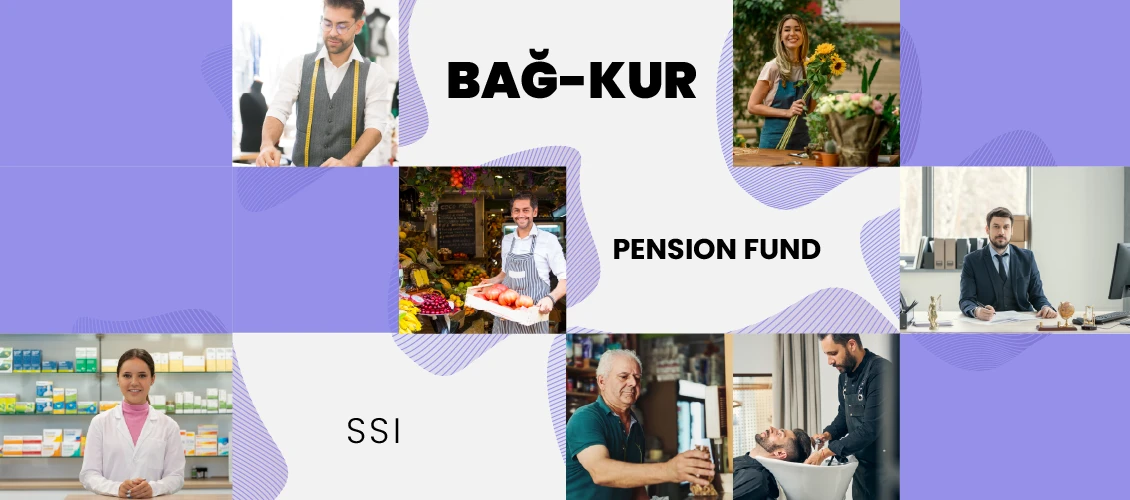17 Haziran 2025
What is BAĞ-KUR? Who is Covered Under the BAĞ-KUR System?

The social security system in Türkiye is structured around three main types of insurance status: 4/a (SSK), 4/b (BAĞ-KUR), and 4/c (Pension Fund). The main objective of this system is to provide social security protection tailored to individuals' forms of employment. BAĞ-KUR (Social Security Organization for Artisans and the Self-Employed), or 4/b status, specifically designed for those working on their own behalf and account, covers a broad group including self-employed professionals, company partners, tradespeople, and artisans.
With the enactment of Law No. 5502 on the Social Security Institution in 2006, all social security institutions were unified under the umbrella of the Social Security Institution (SSI). Since then, BAĞ-KUR has ceased to exist as a separate institution; however, in practice, it still retains its distinctive coverage features. The scope, premium system, and insurance conditions—clearly defined by Law No. 5510 on Social Insurances and General Health Insurance—form the fundamental structure of this status today.
What Is BAĞ-KUR?
BAĞ-KUR is the abbreviation for "Social Insurance Institution for Tradespeople, Artisans, and Other Self-Employed Persons." Under Law No. 5510, which came into force on October 1, 2008, BAĞ-KUR was organized under the 4/b insurance status. The BAĞ-KUR system is a type of social insurance established to secure the social security rights of self-employed individuals. Those insured under BAĞ-KUR benefit from health, old-age, disability, and survivors' insurance and are responsible for paying their own premiums.
The most fundamental difference between BAĞ-KUR and other types of insurance is that the individuals covered operate on their own behalf and account without being affiliated with an employer. Therefore, BAĞ-KUR insured individuals must fully cover their premiums themselves. Today, the expression "to be a BAĞ-KUR member" is still commonly used to describe the place of self-employed individuals within the social security system.
Who Is Insured Under the BAĞ-KUR System?
According to Article 4/b of Law No. 5510, the following individuals are considered insured under the BAĞ-KUR (4/b) system:
- Those who are subject to income tax on commercial earnings or self-employment income, whether under the real or simplified method
- Those who are exempt from income tax but are registered in the tradespeople and artisan's registry
- Company partners, including:
- Partners of general partnerships
- Active and silent partners of limited partnerships
- Partners of shipping partnerships
- Shareholder board members of joint stock companies
- Partners of limited liability companies
- Active partners of partnerships limited by shares
- Individuals engaged in agricultural activities
- Village and neighborhood headmen (muhtars)
- Jockeys and trainers subject to Law No. 6132 on Horse Racing
- Self-employed attorneys and notaries
- Individuals who voluntarily pay premiums under optional insurance
Note: Only the shareholder members of the board of directors in joint stock companies are considered 4/b insured. Other shareholders in such companies are not included within this scope.
What Are the Differences Between SSK and BAĞ-KUR?
Although all types of insurance are unified under a single roof within the social security system, there are implementation differences between 4/a (SSK), 4/b (BAĞ-KUR), and 4/c (Pension Fund):
| Criteria | 4/a (SSK) | 4/b (BAĞ-KUR) |
|---|---|---|
| Status | Employee under an employment contract | Self-employed operating on their own behalf and account |
| Premium Payer | Employer | The insured person themselves |
| Premium Collection Method | Monthly payroll via the employer | Direct declaration and payment to SGK by the insured |
| Premium Rate | Employee share: 14% Employer share: 20.75% Total: 34.75% | Total: 34.75% Optional Insurance: 32% (fully paid by the insured) |
| Unemployment Insurance Premium | 2% employer + 1% employee | Not applicable |
| Late Payment Interest & Penalties | Applied to the employer | Applied directly to the insured person |
| Healthcare Services | Requires active insurance status | Requires minimum premium days and no outstanding debts |
| Retirement Conditions | Women: Age 58 + 7,200 days Men: Age 60 + 7,200 days | Men: Age 60 + 9,000 days Women: Age 58 + 9,000 days |
| Unemployment Benefit | Available | Not Available |
| Maternity and Military Service Credit | Available | Available |
These differences, especially in terms of premium payment arrangements, access to healthcare services, and retirement conditions, indicate that BAĞ-KUR insured individuals bear greater responsibilities.
*Except for optional insurance holders and village/neighborhood headmen (muhtars), those insured under Article 4/1-b who regularly pay their premiums to the Institution may benefit from a 5-point discount on their monthly social insurance premium payments.
How to Start BAĞ-KUR Insurance and Submit an SSI Declaration?
In Türkiye, individuals who work independently on their own behalf and account are included within the scope of social security through BAĞ-KUR (4/b) insurance. This insurance status arises automatically with the commencement of certain activities and must be reported to the Social Security Institution (SSI) by the relevant authorities.
- Start Date and Declaration of BAĞ-KUR Insurance
- • Individuals subject to income tax due to commercial or self-employment income, whether under the real or simplified method, as well as partners of general partnerships, active and silent partners of limited partnerships, and partners of shipping partnerships, are considered insured as of the date their tax liability begins. Tax offices must notify the Institution within two months from the date the liability is established. If tax registration procedures are completed in less than two months, notification to the Institution must be made within 15 days from the completion date, provided it does not exceed two months from the initial establishment date (i.e., the date the tax office enters the taxpayer's details into the system).
- For those exempt from income tax but registered in the tradespeople and artisans' registry, their insurance will begin as of the registry date, and this date must be reported to the Institution by the registry directorates within 15 days at the latest.
- The insurance of shareholder board members of joint stock companies begins on the date they are elected to the board of directors and must be reported by the company officials to the Institution within 15 days at the latest.
- The insurance of limited liability company partners begins on the date the company is registered by the trade registry office and must be reported by the trade registry within 15 days.
- The insurance of active partners of partnerships limited by shares begins on the date the company is registered by the trade registry office and must be reported to the Institution within 15 days from that date by the trade registry.
- For individuals engaged in agricultural work on their own behalf and account, insurance begins on the date they are registered with the agricultural chamber, provided they or the relevant chamber notify the Institution within one year. If the notification is not made within this period, the insurance will begin on the date of notification. In either case, the date must be reported by the agricultural chamber, or—where no chamber exists—by the provincial/district agricultural directorates, within one month from the registration date.
- The insurance of village and neighborhood headmen (muhtars) begins on the date of their election and must be reported by the district or provincial administrative authorities within 15 days from the date they receive their certificate of election.
- The insurance of jockeys and trainers subject to Law No. 6132 on Horse Racing begins on the date they commence actual work following the approval of their license, and this date must be reported to the Institution by the Turkish Jockey Club within one month at the latest.
- Declaration by the Insured Person
- Agricultural activity: Individuals engaged in agricultural work on their own behalf and account who are not registered with an agricultural chamber, or a provincial/district agricultural directorate may apply directly to SGK to initiate their insurance coverage.
- Optional insurance: Individuals who are not covered under any existing insurance status may apply to SSI under the optional insurance scheme to become insured.
- Delayed Notification and Its Consequences
- BAĞ-KUR Insurance Certificate (İB Form)
Note: If notifications are not made within the prescribed timeframes, the relevant institutions may be subject to administrative fines.
In certain cases, it may be necessary for the insured individual to personally notify SSI:
Important: In notifications made personally by the insured individual, the start date of the insurance coverage is considered the date the application is submitted to SSI.
If the relevant institutions fail to submit declarations within the prescribed timeframe, SSI may retroactively initiate the insured status. In such cases, the insured person will incur a retroactive premium debt. Additionally, the responsible institution may be subject to an administrative fine.
Example: If an individual became a taxpayer on January 1, 2025, but the tax office notified SSI on April 1, 2025, SSI will still start the insurance coverage from January 1, 2025, and assess the premium debt retroactively from that date.
In procedures related to BAĞ-KUR insurance, it may be necessary to issue an Insurance Certificate (İB Form). This document must be approved by the relevant institutions and then submitted to SSI. The İB Form can be obtained from SSI directorates or downloaded via SSI's digital services.
BAĞ-KUR insurance coverage arises automatically with the commencement of certain activities and must be reported to SSI by the relevant institutions. However, if notifications are not submitted within the required timeframe, retroactive premium debts may be imposed on the insured person, and administrative fines may be applied to the responsible institutions. Therefore, it is important for insured individuals to monitor their own status and apply to SSI when necessary.
When Does BAĞ-KUR Insurance End?
BAĞ-KUR insurance coverage ends when self-employment or independent activity comes to an end. For example:
- Deregistration from tax records
- Termination of company partnership (e.g., through share transfer, liquidation, etc.)
- Cessation of agricultural activities
- Withdrawal from a cooperative partnership
- End of duty as a village or neighborhood headman
- Cancellation of optional insurance by written request
However, for BAĞ-KUR insurance to officially end, these situations must be reported to SSI either by the relevant institutions or by the insured individual. Otherwise, premium assessments will continue, leading to the accumulation of debt.
Note: Although, since 2008, automatic registration systems have enabled many insurance statuses to be initiated directly in the system, termination processes still require manual follow-up. This may result in significant retroactive premium liabilities in the case of delayed notifications.
Proposed Regulations on BAĞ-KUR Retirement
Equalization of Premium Days: As of 2025, a regulation is being planned to reduce the required number of premium payment days for BAĞ-KUR insured individuals from 9,000 to 7,200. If this regulation is enacted, BAĞ-KUR members will be aligned with SSI and Pension Fund (4/c) insured individuals, gaining the opportunity to retire 5 years earlier.
Scope: The regulation is expected to primarily benefit small tradespeople with fewer than 10 employees (e.g., grocers, butchers, barbers) and farmers. Additionally, BAĞ-KUR insured individuals who began working before September 8, 1999, and fall under the "EYT" (Those Affected by the Retirement Age Requirement)* framework are also anticipated to benefit from this change.
*In Türkiye, the term EYT (Emeklilikte Yaşa Takılanlar) refers to workers who meet the required number of premium days but are not eligible for retirement due to age restrictions.
Retirement Age Condition: Even if the number of premium days is reduced, no change is expected in the retirement age requirement. In other words, the conditions of 58 years of age for women and 60 years for men are anticipated to remain in place.
How Much Is the BAĞ-KUR Retirement Pension for 2025 in Türkiye?
The pension increase rates for the second half of 2025 were determined based on the June inflation data announced by the Turkish Statistical Institute (TÜİK). Accordingly, the pension increase for SSK and Bağ-Kur retirees for the July–December period has been announced as 16.67%.
With this increase, the minimum pension, which was set at TRY 14,469 in January 2025, has been raised to TRY 16,881 as of July 2025.
Conclusion
BAĞ-KUR serves as the foundational component of the social security system for self-employed individuals in Türkiye. However, this status comes with greater responsibilities. Critical factors include the obligation to pay premiums, the requirement for continuous reporting, and the condition of being debt-free in order to access healthcare services.
Accurately identifying the necessary eligibility criteria and ensuring timely completion of declaration procedures are decisive not only for avoiding premium debts but also for determining future retirement pension entitlements.
Notification!






